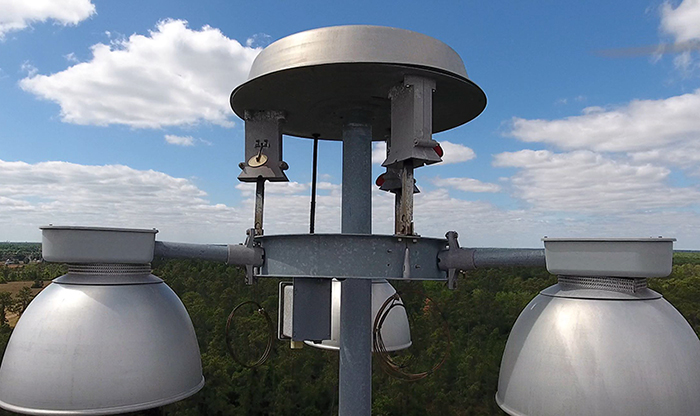High Mast Light Poles Light the Way for Drivers
 By Michael Noesen, PE, and Tim Howell, CBI
By Michael Noesen, PE, and Tim Howell, CBI
It’s a given that nighttime driving is more hazardous than daytime driving. Visibility decreases even when a vehicle’s headlights are on. High mast lighting is one of the tools roadway engineers use to help improve visibility for motorists. It provides a safer environment for motorists when designed and used appropriately.
What Is High Mast Lighting?
High mast lighting refers to light pole standards or derricks that typically range from 60 feet to 150 feet tall. Conventional roadway light poles range from 25 feet to 50 feet above the roadway surface.
High mast lighting for highways has its origins in Europe in the 1950s. As the U.S. interstate system began to expand with higher traveling speeds and more complex, multi-level interchanges, the high mast light systems started to be constructed in America.
How Are High Mast Lights Designed?
The typical high mast light pole (HMLP) has a 4- to 5-foot diameter concrete foundation that extends into the ground 15 to 25 feet or more depending on the installation site’s geotechnical properties. The number and size of anchor bolts that connect the light pole to the concrete foundation is a function of structural design. The light pole itself is usually galvanized or weathered steel.
The lights, technically known as luminaires, are attached to a luminaire ring. The number of lights on the luminaire ring can range from two to 12 depending on the required photometrics. The luminaires are often 400 to 1,000 watts and use high-pressure sodium (HPS) high intensity discharge.
The base of the light pole houses a motorized winch that raises and lowers the luminaire ring via a steel cable system.
For years, HPS luminaires were a cost-effective solution but provided an orange-ish glow. Typical incandescent and fluorescent lights used in homes were high maintenance and inefficient in outdoor conditions. HPS luminaires are now being replaced with LED-type lights that are even more energy efficient and produce the white light (color temperature between 3,000k and 5,000k) that people tend to prefer.
The lenses on the luminaires have been precisely grooved to produce different light patterns that range from a full circle to a long and narrow oval. The different luminaires are classified by the light patterns and used in the photometric design to direct light and intensity to specific areas.
What Are the Advantages of High Mast Lighting?
High mast lighting has inherent advantages over conventional lighting:
- The higher mounting lights provide a more visible and uniform lighted area for the driver.
- High mast light poles can be set back farther from the edge of pavement, outside the clear zone, which reduces the likelihood of a collision and provides maintenance workers a safer area to work. Conventional light poles are often located within the clear zone and often need to be replaced due to collisions in roadway curves and interchange ramps.
- One strategically located HMLP can replace 10 to 15 conventional light poles.
- Maintenance workers do not have to close a lane of traffic and work alongside traffic when performing maintenance on HMLPs as opposed to conventional roadway light poles.
- High mast lighting is better suited than conventional lighting at complex interchanges where a well-lit area can help the higher-speed driver in making timely decisions.
Are There Disadvantages to High Mast Lighting?
One of the disadvantages of high mast lighting is “light trespass.” With HMLPs often at 120 feet above the ground, the cone of light spills into nearby residential areas. As population and traffic have increased, once-rural interchanges have become more urbanized with commercial and residential developments. Residential homeowners and homeowner associations tend to complain about the light from high mast lighting. To counter the complaints, high mast lights can be fitted with shields that direct the light straight down as opposed to spilling across the right-of-way and into residential areas.
In Florida, the high mast lights are lowered when a hurricane warning is issued. Lowering the high mast lights decreases the wind loading and hopefully minimizes damage to the light pole.
High mast lights are sometimes used as nesting sites for ospreys although highly discouraged because of maintenance requirements. The heat generated from luminaires creates a warm nesting site.
Lightning is also prevalent in Florida, and the state requires lightning rods and grounding for HMLPs to minimize damage from lightning strikes.
How Do You Know a High Mast Light Pole Is Safe?
Ayres structural inspectors regularly inspect high mast light poles throughout Florida. Galvanized poles need to be inspected every five years, and weathering steel poles need inspection every two years. The current design standard in Florida allows only galvanized poles.
Major structural elements to be inspected are the foundation, anchor bolts, steel base plate, and steel pole and splices. High mast light pole design has improved significantly over the past 20 years, and fatigue cracking is rarely an issue now. The biggest issues are corrosion, loose anchor bolts, and issues with the mechanical/electrical systems, which are secondary to the structural inspection.
The primary method to inspect the poles is with a spotter’s scope and binoculars from at least three sides. Bucket trucks can also be used at times. The biggest challenge is usually accessing the pole foundations, as they are often constructed at large interchanges on the sides of steep slopes or in heavily vegetated areas.

About the Expert:
Michael Noesen is a senior transportation engineer based in Ayres’ Tampa, Florida, office at Hidden River Parkway. He has more than three decades of experience in urban and rural roadway projects as well as lighting and signalization.

About the Expert:
Tim Howell is a certified bridge inspector based in Ayres’ Titusville, Florida, office. In addition to inspecting high mast light poles, Tim is experienced in inspecting movable bridges, fixed bridges, tunnels, overhead sign structures, and traffic signal mast arms.
Contact Michael Noesen for more information about HMLP design, and Tim Howell for more about HMLP inspection.

Comments are closed.